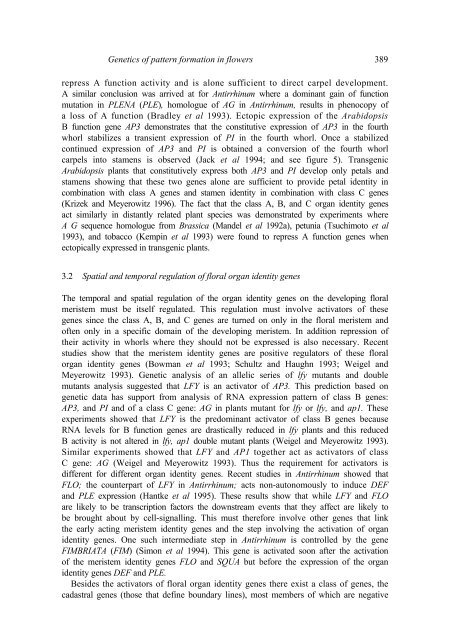Genetic regulation of flower development - Indian Academy of ...
Genetic regulation of flower development - Indian Academy of ...
Genetic regulation of flower development - Indian Academy of ...
Create successful ePaper yourself
Turn your PDF publications into a flip-book with our unique Google optimized e-Paper software.
<strong>Genetic</strong>s <strong>of</strong> pattern formation in <strong>flower</strong>s 389<br />
repress A function activity and is alone sufficient to direct carpel <strong>development</strong>.<br />
A similar conclusion was arrived at for Antirrhinum where a dominant gain <strong>of</strong> function<br />
mutation in PLENA (PLE), homologue <strong>of</strong> AG in Antirrhinum, results in phenocopy <strong>of</strong><br />
a loss <strong>of</strong> A function (Bradley et al 1993). Ectopic expression <strong>of</strong> the Arabidopsis<br />
Β function gene AP3 demonstrates that the constitutive expression <strong>of</strong> AP3 in the fourth<br />
whorl stabilizes a transient expression <strong>of</strong> PI in the fourth whorl. Once a stabilized<br />
continued expression <strong>of</strong> AP3 and PI is obtained a conversion <strong>of</strong> the fourth whorl<br />
carpels into stamens is observed (Jack et al 1994; and see figure 5). Transgenic<br />
Arabidopsis plants that constitutively express both AP3 and PI develop only petals and<br />
stamens showing that these two genes alone are sufficient to provide petal identity in<br />
combination with class A genes and stamen identity in combination with class C genes<br />
(Krizek and Meyerowitz 1996). The fact that the class A, B, and C organ identity genes<br />
act similarly in distantly related plant species was demonstrated by experiments where<br />
A G sequence homologue from Brassica (Mandel et al 1992a), petunia (Tsuchimoto et al<br />
1993), and tobacco (Kempin et al 1993) were found to repress A function genes when<br />
ectopically expressed in transgenic plants.<br />
3.2 Spatial and temporal <strong>regulation</strong> <strong>of</strong> floral organ identity genes<br />
The temporal and spatial <strong>regulation</strong> <strong>of</strong> the organ identity genes on the developing floral<br />
meristem must be itself regulated. This <strong>regulation</strong> must involve activators <strong>of</strong> these<br />
genes since the class A, B, and C genes are turned on only in the floral meristem and<br />
<strong>of</strong>ten only in a specific domain <strong>of</strong> the developing meristem. In addition repression <strong>of</strong><br />
their activity in whorls where they should not be expressed is also necessary. Recent<br />
studies show that the meristem identity genes are positive regulators <strong>of</strong> these floral<br />
organ identity genes (Bowman et al 1993; Schultz and Haughn 1993; Weigel and<br />
Meyerowitz 1993). <strong>Genetic</strong> analysis <strong>of</strong> an allelic series <strong>of</strong> lfy mutants and double<br />
mutants analysis suggested that LFΥ is an activator <strong>of</strong> AP3. This prediction based on<br />
genetic data has support from analysis <strong>of</strong> RNA expression pattern <strong>of</strong> class Β genes:<br />
AP3, and PI and <strong>of</strong> a class C gene: AG in plants mutant for lfy or lfy, and ap1. These<br />
experiments showed that LFΥ is the predominant activator <strong>of</strong> class Β genes because<br />
RNA levels for Β function genes are drastically reduced in lfy plants and this reduced<br />
Β activity is not altered in lfy, ap1 double mutant plants (Weigel and Meyerowitz 1993).<br />
Similar experiments showed that LFY and AP1 together act as activators <strong>of</strong> class<br />
C gene: AG (Weigel and Meyerowitz 1993). Thus the requirement for activators is<br />
different for different organ identity genes. Recent studies in Antirrhinum showed that<br />
FLO; the counterpart <strong>of</strong> LFY in Antirrhinum; acts non-autonomously to induce DEF<br />
and PLE expression (Hantke et al 1995). These results show that while LFY and FLO<br />
are likely to be transcription factors the downstream events that they affect are likely to<br />
be brought about by cell-signalling. This must therefore involve other genes that link<br />
the early acting meristem identity genes and the step involving the activation <strong>of</strong> organ<br />
identity genes. One such intermediate step in Antirrhinum is controlled by the gene<br />
FIMBRIATA (FIM) (Simon et al 1994). This gene is activated soon after the activation<br />
<strong>of</strong> the meristem identity genes FLO and SQUA but before the expression <strong>of</strong> the organ<br />
identity genes DEF and PLE.<br />
Besides the activators <strong>of</strong> floral organ identity genes there exist a class <strong>of</strong> genes, the<br />
cadastral genes (those that define boundary lines), most members <strong>of</strong> which are negative

















